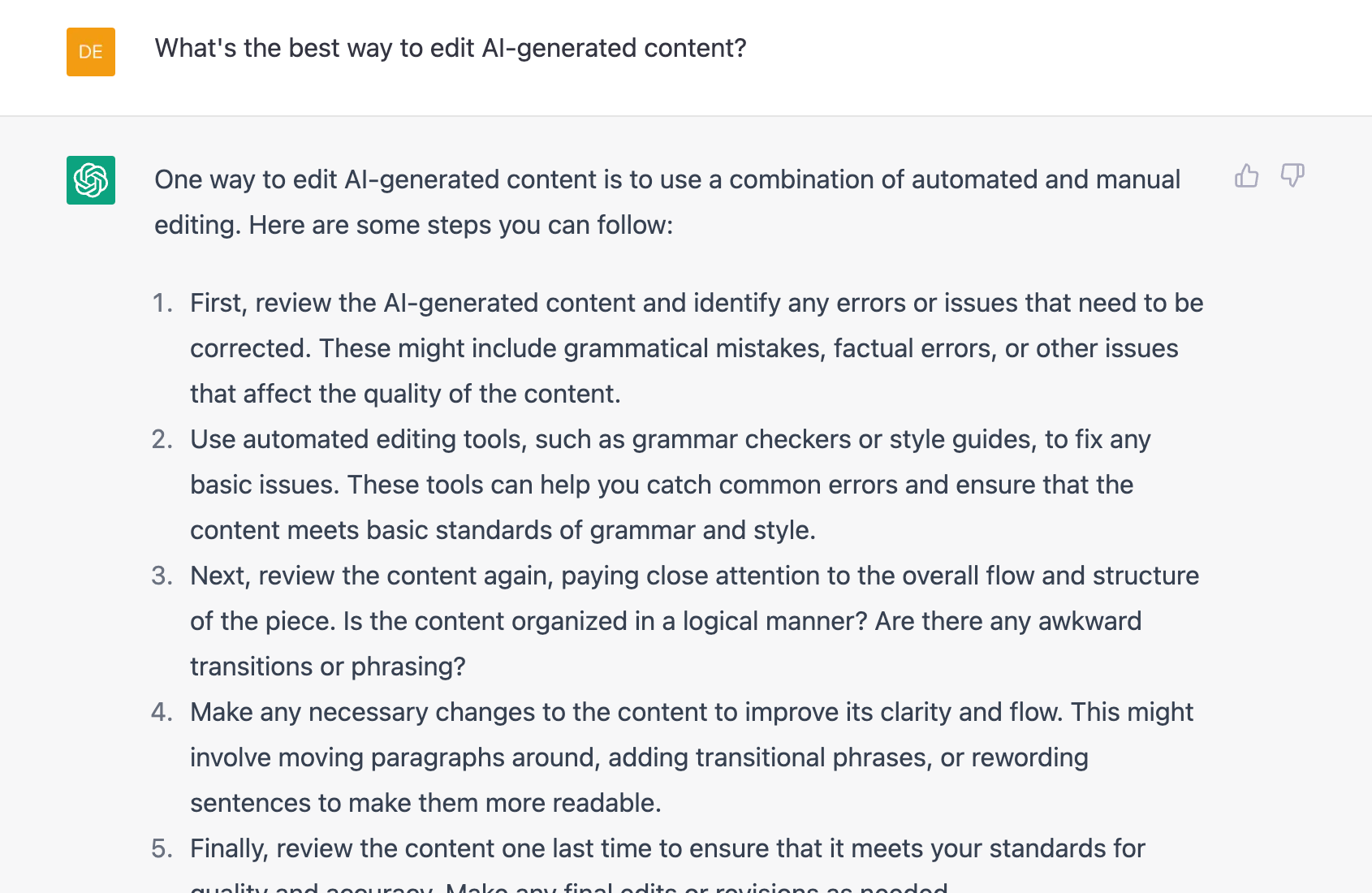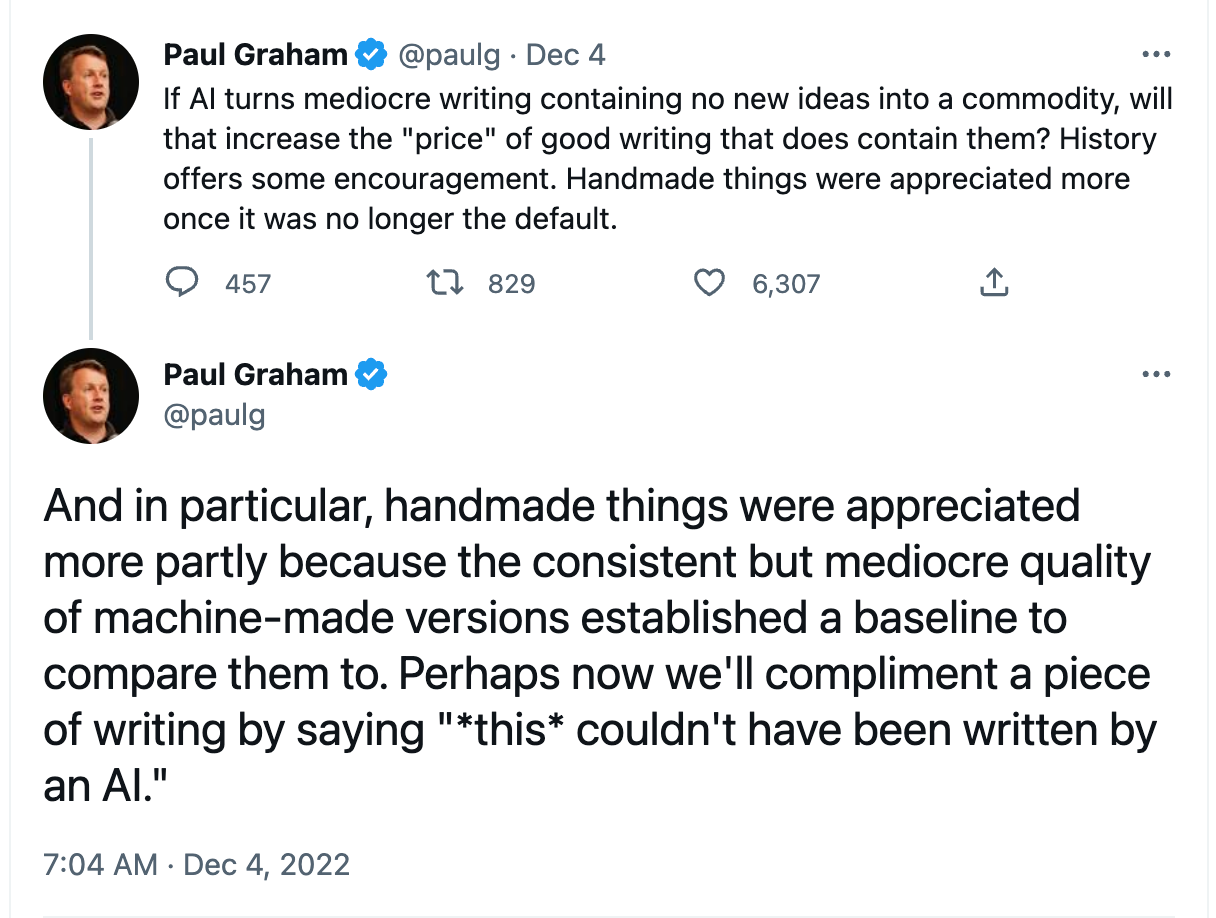This essay originally was published on March 23, 2023, with the email subject line "CT No. 160: Don't fear the robot."
Editor's note: The Content Technologist has an existing partnership with Writer.com. The writer of this article received free access to Writer as part of that partnership, but no other guidance when writing and evaluating the tool's output.
In January I returned from a trip to a new work reality: my once-overflowing calendar was suddenly eerily quiet. Client projects that seemed like a done deal were delayed or canceled. Coincidentally, or maybe not, this was shortly after ChatGPT-3.5 was released and garnered mainstream adoption. Doomsday messages circulated in my freelance writing groups: screenshots of client emails announcing that they would soon implement AI solutions for content creation and need to reduce their budgets — or eliminate freelance writers completely.
As a technology journalist and freelance content creator, my initial reaction was fascination. We’ve reached an inflection point that Bill Gates described as being “as fundamental as the creation of the microprocessor.”
I was long aware of GPT-3 and played around with tools like Chibi AI and Jasper at the tail end of 2022. After my initial tests, I wasn’t worried. While the tools provided a coherent string of text, it was nowhere near what a quality human writer could do. The personality in the writing wasn’t there. The cadence was monotone and…well, robotic.
But as newer iterations of AI chatbots and content generators are released, I’m experiencing a bittersweet mix of excitement and fear. If GPT-4, which can purportedly do things that GPT-3 can’t, like build a website from a handwritten note, what will GPT-5 or 6 output? How will knowledge workers, specifically content professionals, adjust to thrive in this new reality?
The Human-AI Creative Symbiosis
Last year, I was lucky that my lull in work was temporary. I’m sure in the future I’ll lose some work because of generative AI, but it'll be a blessing in disguise. If a business believes they can replace the value of human input, then they weren’t the right client for me.
That said, generative AI has the immense power to transform content production. After testing out many of the tools generally available, I’ve identified the best ways that writers can use popular AI writing generation tools for ideation, support, and research.
*The screenshots below are from Chat GPT-3.5 unless otherwise specified.
1. Beat writer’s block, faster
Nothing leads to writer’s block like a blank page with an angry cursor blinking at you. The internet abounds with exercises for beating that block, but none of them are tailored to your topic. That’s where AI comes in. I struggle with writing introductions, but now I can ask GPT to help me get started.
Not too bad, but it’s quite bland. Let’s try a more specific request:
Better, but it sounds like any other blog on the topic. Let’s up the ante:
Of course, the prompt and the output are absurd, but I find this type of left-field writing to be the most inspiring.
Key takeaways:
- The quality of your input dictates the quality of the output. Be specific about what the tool should or shouldn’t do.
- Share as many details as possible about the tone of voice, the industry, and the goal of your content.
- Blend elements from other industries and perspectives to get more original results.
Article continued below

Want to find a better way to evaluate your web content performance and understand how your content affects your business? Looking to level up your digital strategy skills?
Take Understanding Google Analytics 4, and learn the key metrics and setup that leading website owners and content professionals use to evaluate and plan for content.
Designed especially for non-marketers and non-data scientists.
2. Generate topic ideas
For those who cross over from pure writing into content strategy, AI can support topic planning and ideation. Let’s start with another sales blog prompt:
There’s nothing wrong with these topics, but they’re obvious. Nothing on this list will push your website to the first page of Google or intrigue a curious audience to stick around. Let’s spice up that prompt:
Are these results usable? Maybe not, and that’s okay. They’re just supposed to get our creative juices flowing.
Key takeaways:
- Don’t take outputs at face value. Instead, use them as a starting point for creating something of your own.
- Look for unusual phrasing or combinations of words to come up with original ideas.
- Dig deeper into attention-catching language with more prompts.
3. Generate outlines
While the makers of GPT-4 claim the new version can take in 25,000-word inputs, when I tried pasting a 6,000 word transcript, I got the following: “the message you submitted was too long, please reload the conversation and submit something shorter.”
When I pasted the same transcript in Writer.com, I received an outline, but the result was rudimentary. The tool picked out keywords from the conversation, but it didn’t create a detailed outline that flowed well enough for a high-quality story.
With Writer, Writesonic, and the OpenAI playground (but not ChatGPT), I could paste high-performing links and prompt the tools to generate an outline based on the content of those pages. The results required heavy editing, but output was a good start for synthesizing the most common points I needed to cover when writing a high-performing article.
Output from Writesonic
The simplest way, though, to get an original outline is to feed an AI writing tool your notes on a topic (just make sure that you trust the tool won’t use your intellectual property for its training data).
Or, if you’re feeling lucky, you can use the topics the tool generated from an earlier prompt and ask it to create an outline for you.
Key takeaways:
- Use different sources for generating outlines, but expect to do some heavy editing.
- Use existing high-performing links to build an outline, and then add to it.
- Be specific on keywords, themes and tone of voice you want to cover.
4. Summarize complex ideas
AI can save hours if you’re trying to wrap your head around technical concepts and break them down in easy-to-digest terms. Summaries of web search results can be a foundation for your own understanding of the topic, or a starting point to explain concepts to your audience. They can also rephrase academic or technical text into a far less jargony output.
Here, I used a prompt from an actual study on the effects of food on brain function and asked ChatGPT to re-word it in simpler terms:
When I come across a topic that I’m unfamiliar with, AI tools generally give concise explanations:
When using this content, I need to cross-check the information and provide links to actual studies from reputable sources, but the AI’s summary is a solid step toward understanding complex ideas.
Key takeaways:
- Translate heavy technical or academic text into simpler terms.
- Use AI’s summarization abilities to understand difficult topics, faster.
- Fine-tune your work by using AI to simplify complex ideas.
5. Eliminate obvious ideas from your writing
Originality in language and ideation can help both search engines and human audiences categorize content as high quality. You don’t want AI to rehash the same ideas hundreds of other websites have already published on the topic.
When I asked the AI for tips on improving sales, its suggested topics were pretty mainstream. If I run the same prompt a few times, I can spot patterns and identify repeating topics. Using human expertise, I can deduce what’s missing from the list that could be a unique take.
Key takeaways:
- Assume AI will generate the most mainstream ideas, then eliminate those from your writing.
- Probe the tool for more unconventional suggestions.
- Play with inputting tone of voice or industry knowledge to generate unusual answers.
The limitations of AI-powered content tools
Businesses automate processes to cut costs on human labor, reveling in the efficiency of AI. But many AI tools remain cartoonish in the content creation process. Writers still have the uniquely human opportunity to:
- Verify, edit and fact-check AI-generated outputs. AI can be notoriously overconfident in providing misinformation or hallucinating results entirely. Many tools have a disclaimer which says just as much.
2. Nail a company’s brand voice in all AI-generated content - AI tools can be funny or authoritative on demand, but they can’t imbue the content with your unique brand voice.
3. Spruce up generic AI output to make it informative. In niche or fast-moving industries, recent developments may not be part of the AI tool’s training data. Human writers are essential for embedding product or service knowledge unique to a brand.
4. Conduct thorough research by interviewing experts and cross-checking credible sources for the most accurate information.
Screenshot of links provided by ChatGPT, none of which worked.
Sifting through the AI Toolbox
I used ChatGPT for most of my experimentation, but there’s a plethora of other options out there. Here’s a high level overview of some of the tools on the market, though, the list isn’t comprehensive.
Keeping an eye on what's next
We’re at the precipice of a robot-powered revolution. The internet already abounds with examples of people using AI tools to generate business ideas, invent incredible stories and provide unique solutions to solve real problems. As a writer, it’s clear using these tools will improve my work, and I’m enjoying experimenting with them.
That said, as with any technology, we should never abandon our critical thinking faculties for the expedience these tools offer. For all the marvelous ideas and stories they tell, they can also be weaponized as tools for misinformation and manipulation. It’s up to us to discern between what’s valuable and what belongs in the bin.
Natasha Serafimovska is a freelance writer with six years of industry experience in EdTech/SaaS, covering a number of tech verticals including emerging tech, unified comms, IoT and digital transformation. Natasha also works as an executive ghostwriter for Fortune 500 companies, and her work has been featured in TechCrunch, Entrepreneur, Newsweek, and more.
Hand-picked related content






